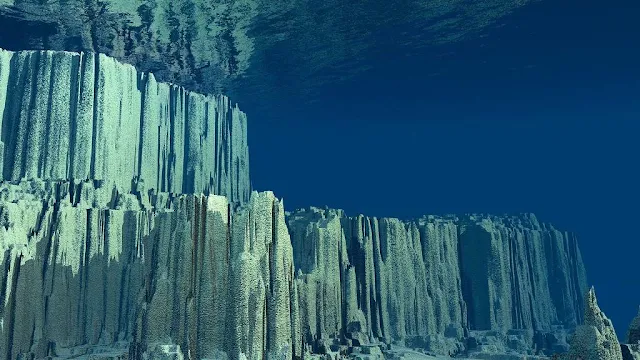Geologist Unearths 340 Million-Year-Old Floor of 'Lost Ocean'
 |
| Geologist Unearths 340 Million-Year-Old Floor of 'Lost Ocean'. Photo: Richard Legard. |
Earth's oldest oceanic crust: Geologist finds floor of 'lost ocean' that formed 340 million years ago, long before the Atlantic was created
At the bottom of the eastern Mediterranean Sea lies the world’s oldest oceanic crust, according to a new study.
Dr. Roi Granot of the Ben-Gurion University of the Negev in Israel has discovered that an oceanic crust that has been hiding in the sea’s sediment-ridden waters may have been part of the ancient Tethys Ocean, according to a release from the university.
Granot believes the 60,000-square-mile crust may have also been formed around the time Earth’s landmasses formed the supercontinent Pangea, reports Business Insider.
With the use of magnetic data, Granot and his research team analyzed the crust’s structure in the basin and discovered that the rocks are characterized by magnetic stripes, the hallmark of oceanic crust that formed at a mid-ocean ridge, according to the release. As magma at a mid-ocean ridge axis cools off, magnetic minerals in the newly forming rocks align in the direction of Earth’s magnetic field.
Over time, changes in the field’s orientation are recorded in the ocean floors, creating a unique “barcode” that provides a timestamp of when the crust formed.
“I use the shape, or skewness, of these magnetic anomalies to constrain the timing of crustal formation and find that it formed about 340 million years ago,” Granot wrote in the study.
“I suggest that this oceanic crust formed either along the Tethys spreading system, implying the Neotethys Ocean came into being earlier than previously thought, or during the amalgamation of the Pangaea Supercontinent.”
Oceanic crust has a high density, which causes it to be recycled back into the Earth’s mantle relatively fast at subduction zones, according to the release. This means most of the crust is less than 200 million years old – significantly younger than the mass found by Granot.
“We don’t have intact oceanic crust that old … It would mean that this ocean was formed while Pangaea, the last supercontinent, was in the making,” Granot told Business Insider.
"But we are not sure that it is really part of the Tethys Ocean,” he added. “It could be that this oceanic crust is not related at all.”
The Tethys Ocean was a former tropical body of salt water that existed during much of the Mesozoic Era, according to Britannica.
It separated the supercontinent of Laurasia, which is now North America and the portion of Eurasia that lies north of the Alpine-Himalayan mountain ranges, and the Gondwana, which is present-day South America, Africa, peninsular India, Australia, Antartica and those Eurasian regions south of the mountain chain.
The above post is reprinted from materials provided by Ben-Gurion University.
Dr. Roi Granot of the Ben-Gurion University of the Negev in Israel has discovered that an oceanic crust that has been hiding in the sea’s sediment-ridden waters may have been part of the ancient Tethys Ocean, according to a release from the university.
Granot believes the 60,000-square-mile crust may have also been formed around the time Earth’s landmasses formed the supercontinent Pangea, reports Business Insider.
Over time, changes in the field’s orientation are recorded in the ocean floors, creating a unique “barcode” that provides a timestamp of when the crust formed.
“I use the shape, or skewness, of these magnetic anomalies to constrain the timing of crustal formation and find that it formed about 340 million years ago,” Granot wrote in the study.
“I suggest that this oceanic crust formed either along the Tethys spreading system, implying the Neotethys Ocean came into being earlier than previously thought, or during the amalgamation of the Pangaea Supercontinent.”
Oceanic crust has a high density, which causes it to be recycled back into the Earth’s mantle relatively fast at subduction zones, according to the release. This means most of the crust is less than 200 million years old – significantly younger than the mass found by Granot.
“We don’t have intact oceanic crust that old … It would mean that this ocean was formed while Pangaea, the last supercontinent, was in the making,” Granot told Business Insider.
"But we are not sure that it is really part of the Tethys Ocean,” he added. “It could be that this oceanic crust is not related at all.”
The Tethys Ocean was a former tropical body of salt water that existed during much of the Mesozoic Era, according to Britannica.
It separated the supercontinent of Laurasia, which is now North America and the portion of Eurasia that lies north of the Alpine-Himalayan mountain ranges, and the Gondwana, which is present-day South America, Africa, peninsular India, Australia, Antartica and those Eurasian regions south of the mountain chain.
The above post is reprinted from materials provided by Ben-Gurion University.


%20(1).webp)





.jpg)